(Press-News.org) How we move is an excellent indicator of overall health. When we feel good, we move around continually. When we're in pain, we reduce our physical activity. This observation might seem trivial, but it has led to an original approach for evaluating chronic pain. A team from EPFL's Laboratory of Movement Analysis and Measurement (LMAM) has developed a clever, easy-to-use visual tool to help doctors assess their patients' pain levels. The research appears online February 23 in the journal PLoS One.
"Movement is an objective indicator of pain. You move differently if you're in pain than you do if you're completely healthy," explains EPFL scientist Anisoara Ionescu. "It's important for doctors to be able to evaluate that pain as precisely as possible." Using data collected by sensors placed on different parts of the body, she explains, a doctor can quantify a patient's suffering, monitor progress and adapt treatment appropriately.
Doctors typically try to assess the severity of chronic pain with an in-depth oral evaluation using a series of standard questionnaires. This method, however, gives a very static view of the patient's condition – how he or she felt on this day, at that time. There are other problems with this approach as well. Patients rate their pain on a scale from 1 to 10; but obviously we don't all feel a "5" in the same way. And some patients, such as children or the cognitively impaired, are simply unable to describe or communicate their pain at all.
Movement as an indicator
The EPFL study monitored the physical activity of 15 healthy, pain-free subjects and 60 patients suffering from chronic pain. Sensors equipped with gyroscopes and accelerometers were attached to their chests and adjacent to their knees and ankles. The sensors recorded all the subjects' movements and periods of rest. The result: those who reported chronic pain moved differently than the healthy subjects; in particular, their active periods were punctuated by numerous brief rest intervals. Using the new tool, the researchers were able to take data several days before, during and after treatment. Results from the different periods could be compared to obtain a precise assessment of how the treatment changed a patient's day to day activities.
"There is definitely a difference in behavior between healthy and chronically ill patients," says Dr. Eric Buchser, a professor at the hospital in Morges, Switzerland, who is participating in the study. "But we're just starting to collect data. We still need to gather more and establish objective reference values between patients."
Pain – in all its manifestations
The LMAM laboratory has been working with the department of anesthesiology and pain management at the Morges hospital, which Buchser heads, for ten years. "Our first studies focused on acute pain, and then we moved to the more persistent, nagging suffering known as chronic pain. However, we had very little objective information on the intensity of this kind of pain."
Walking, running, sitting, and lying down are all objective indicators. The scientists defined 18 different activity states: various combinations of activity type, intensity, duration, and how the activity is distributed over time. They used the temporal sequence of these different states to develop a visual tool, a kind of color 'barcode,' that would be easy for doctors to use on a daily basis. The structural complexity of the barcode was an indication of pain intensity. In a single glance, a doctor can see a patient's situation, his or her progress, and the effect of an applied treatment protocol. Buchser has high hopes for the tool. "Eventually, the doctor could use this physical activity "barcode" to help make a diagnosis, better target a therapy, evaluate its effectiveness, and adapt it appropriately over time."
###Contact:
Michael Mitchell
International Press Officer
EPFL
michael.mitchell@epfl.ch
+41 21 693 70 22
Anisoara Ionescu
Scientist
Laboratory of Movement Analysis and Measurement, EPFL
anisoara.ionescu@epfl.ch
+41 21 69 35626
Getting a handle on chronic pain
New 'barcode' tool lets doctors evaluate chronic pain quickly and objectively
2012-02-24
ELSE PRESS RELEASES FROM THIS DATE:
Researchers find a key to growth differences between species
2012-02-24
The tiny, little-noticed jewel wasp may provide some answers as to how different species differ in size and shape. And that could lead to a better understanding of cell growth regulation, as well as the underlying causes of some diseases.
Using the wings of these insects as a tool to study how growth is regulated, biologists at the University of Rochester have discovered that changes in expression of a well-known cell regulator gene called "unpaired" (upd) accounts for wing growth differences between males of closely related species. Unpaired is distantly related to ...
Researchers discover how vitamin D inhibits inflammation
2012-02-24
Researchers at National Jewish Health have discovered specific molecular and signaling events by which vitamin D inhibits inflammation. In their experiments, they showed that low levels of Vitamin D, comparable to levels found in millions of people, failed to inhibit the inflammatory cascade, while levels considered adequate did inhibit inflammatory signaling. They reported their results in the March 1, 2011, issue of The Journal of Immunology.
"This study goes beyond previous associations of vitamin D with various health outcomes. It outlines a clear chain of cellular ...
Higher risk of autism among certain immigrant groups
2012-02-24
A major register study from the Swedish medical university Karolinska Institutet shows that children born to certain groups of immigrants in Sweden had an increased risk of developing autism with intellectual disability. The study includes all children in Stockholm County from 2001 to 2007, and brings the question of the heredity of autism to the fore.
"This is an intriguing discovery, in which we can see strong links between a certain kind of autism and the time of the mother's immigration to Sweden," says principal investigator Cecilia Magnusson, Associate Professor ...
How 1-year-olds can recognize beliefs of others
2012-02-24
Prof. Dr. Albert Newen and Dr. Leon de Bruin from the Institute of Philosophy II at the Ruhr-Universität explain their theory in the journal Cognition. In the first year of life, children already have a basic "theory of mind", that is, they are capable of distinguishing their own beliefs from those of others. At the age of four, this capacity is fully developed. According to the Bochum model, this development is guided by two interacting systems.
Contradictory results: "false belief" test with and without language
The test: Sally puts her ball into a basket and goes ...
Parkinson's disease patients can become more creative when they take dopamine
2012-02-24
Some Parkinson's Disease patients can suddenly become creative when they take dopamine therapy, producing pictures, sculptures, novels and poetry. But their new-found interests can become so overwhelming that they ignore other aspects of their everyday life, such as daily chores and social activities, according to research published in the March issue of the European Journal of Neurology.
Italian researchers studied 36 patients with Parkinson's Disease - 18 with increased artistic production and 18 without - and compared them with 36 healthy controls without Parkinson's. ...
Cebit 2012 -- Internet service prevents cable tangle in presentations at conferences
2012-02-24
To connect a laptop to an additional monitor, projector or even to a monitor wall, a special cable was required, until now. Researchers of the Saarland University's Intel Visual Computing Institute overcome this obstacle by linking computer and monitor via an 'Internet Service'. By this means, a screen's contents can be shifted freely to any terminal's display and even shown on large-scale monitor walls. The Saarland University's scientists present their results for the first time at stand F34, in hall 9 at the computer fair Cebit. The trade show takes place in Hannover ...
Fear of job loss causes dissatisfaction and a lack of commitment at work
2012-02-24
A study in Spain shows that insecurity at work is directly and negatively linked to satisfaction in work and life, as well as affecting performance and commitment. Furthermore, the research reveals that the consequences of this insecurity are different according to the occupational group they work in.
A study led by Spanish psychologists has concluded that the feeling that one is going to lose their job worsens satisfaction levels in other areas of life, such as family, health, financial circumstances and the work-free time balance.
As the fear of unemployment increases ...
First study to show that bisphenol A exposure increases risk of future onset of heart disease
2012-02-24
Bisphenol A (BPA) is a controversial chemical widely used in the plastics industry. A new study followed people over a 10-year time period and shows that healthy people with higher urine concentrations of BPA were more likely to later develop heart disease.
The study was carried out by researchers at the Peninsula College of Medicine and Dentistry, the University of Exeter and the European Centre for the Environment and Human Health, in association with the University of Cambridge. The analysis was funded by the British Heart Foundation. The paper is published online ...
Exclusive interview with lead spacewalker on Endeavour's final mission
2012-02-24
In an exclusive interview with Physics World, astronaut Drew Feustel gives a vivid account of his two missions into space and recalls his determination to make his childhood ambition – space flight – come true.
In the video, Feustel discusses his two missions – his maiden flight in 2009, as part of a team sent to repair the Hubble Space telescope, and his return to space in 2011 as the lead spacewalker on Endeavour's final mission to the International Space Station.
Recalling the first moments of launch, when you're sitting on the launch pad and the countdown hits ...
Recalling items from memory reduces our ability to recall other related items
2012-02-24
Researchers at the universities of Granada and Jaén, Spain, have discovered why recalling some items from memory reduces our ability to recall other related items. In the field of Psychology, this phenomenon is known as "Retrieval-Induced Forgetting" (RIF), and researchers have determined the cognitive process that causes this phenomenon and its duration.
To carry out this study, the researchers designed a set of memory tasks where the participants had to learn a material and then recall it partially. Memory tasks had different levels of difficulty and included different ...
LAST 30 PRESS RELEASES:
Heart-brain connection: international study reveals the role of the vagus nerve in keeping the heart young
Researchers identify Rb1 as a predictive biomarker for a new therapeutic strategy in some breast cancers
Survey reveals ethical gaps slowing AI adoption in pediatric surgery
Stimulant ADHD medications work differently than thought
AI overestimates how smart people are, according to HSE economists
HSE researchers create genome-wide map of quadruplexes
Scientists boost cell "powerhouses" to burn more calories
Automatic label checking: The missing step in making reliable medical AI
Low daily alcohol intake linked to 50% heightened mouth cancer risk in India
American Meteorological Society announces Rick Spinrad as 2026 President-Elect
Biomass-based carbon capture spotlighted in newly released global climate webinar recording
Illuminating invisible nano pollutants: advanced bioimaging tracks the full journey of emerging nanoscale contaminants in living systems
How does age affect recovery from spinal cord injury?
Novel AI tool offers prognosis for patients with head and neck cancer
Fathers’ microplastic exposure tied to their children’s metabolic problems
Research validates laboratory model for studying high-grade serous ovarian cancer
SIR 2026 delivers transformative breakthroughs in minimally invasive medicine to improve patient care
Stem Cell Reports most downloaded papers of 2025 highlight the breadth and impact of stem cell research
Oxford-led study estimates NHS spends around 3% of its primary and secondary care budget on the health impacts of heat and cold in England
A researcher’s long quest leads to a smart composite breakthrough
Urban wild bees act as “microbial sensors” of city health.
New study finds where you live affects recovery after a hip fracture
Forecasting the impact of fully automated vehicle adoption on US road traffic injuries
Alcohol-related hospitalizations from 2016 to 2022
Semaglutide and hospitalizations in patients with obesity and established cardiovascular disease
Researchers ‘listen in’ to embryo-mother interactions during implantation using a culture system replicating the womb lining
How changing your diet could help save the world
How to make AI truly scalable and reliable for real-time traffic assignment?
Beyond fragmented markets: A new framework for efficient and stable ride-pooling
Can shape priors make road perception more reliable for autonomous driving?
[Press-News.org] Getting a handle on chronic painNew 'barcode' tool lets doctors evaluate chronic pain quickly and objectively


